Truthseeking in Art and History
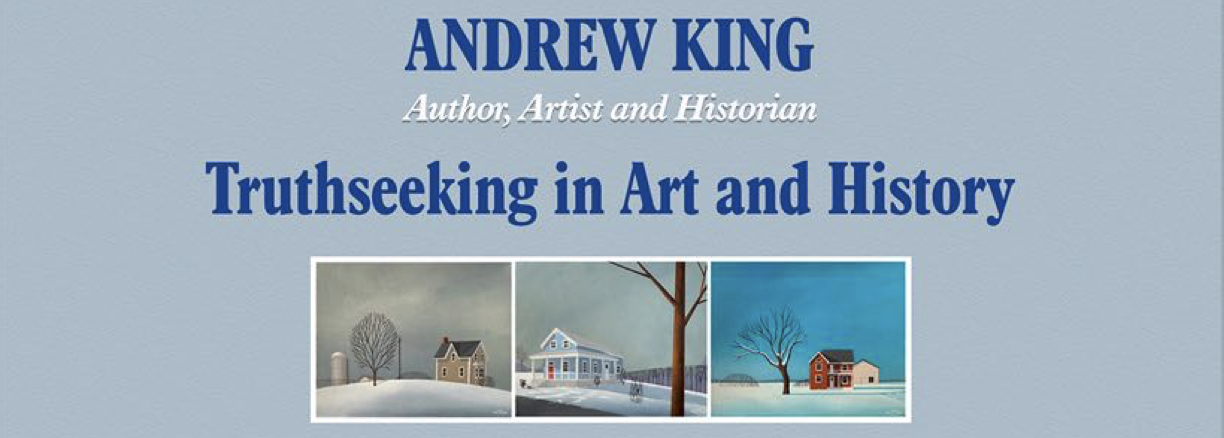
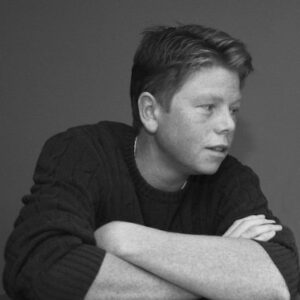
~ Report by Myra McFarlane ~
January, 2022
Andrew King, a local artist and amateur historian, shared with us the latest results of his ongoing and wide-ranging curiosity as it relates to both his art and his historical meanderings.
Coming from his stated perspective that history ought to be accessible to anyone who is interested, Andrew’s talk was of a largely personal nature, and began with an anecdote that many of us could relate to: an encounter with a gentleman attired in Victorian style fashion who squired him through the Dickinson House Museum, doing so in a way that left a lasting impression on Andrew (a perfect example of accessible history if ever there was one.) We’re pretty sure the well-dressed gentleman was none other than our own Bill Tupper. The world is small.
That encounter just whetted Andrew’s curiosity, and the paintings he shared with us all have some local significance and of course a story. Many of us recognized the buildings in the paintings: from AY Jackson’s studio as it might have looked when he built it, to the old Weaver House on Mill St. For Andrew, every building tells a story.
The Lost Village of Long Island
While on his walks, Andrew discovered the “lost village” of Long Island, through finding some toppled tombstones up near the Long Island Locks. Curiosity piqued, he began to investigate. Different types of researchers use different technologies to uncover secrets of place, and Andrew is no different.
Andrew’s original source is the well-known and wellloved Carleton County Atlas (here’s where you can buy your own copy - https://atticbooks.ca/products/113218), you can see it at the Rideau Township Archives in North Gower, or you can see it digitally here: https://www.canadiana.ca/view/oocihm.12020/5?r=0&s=1
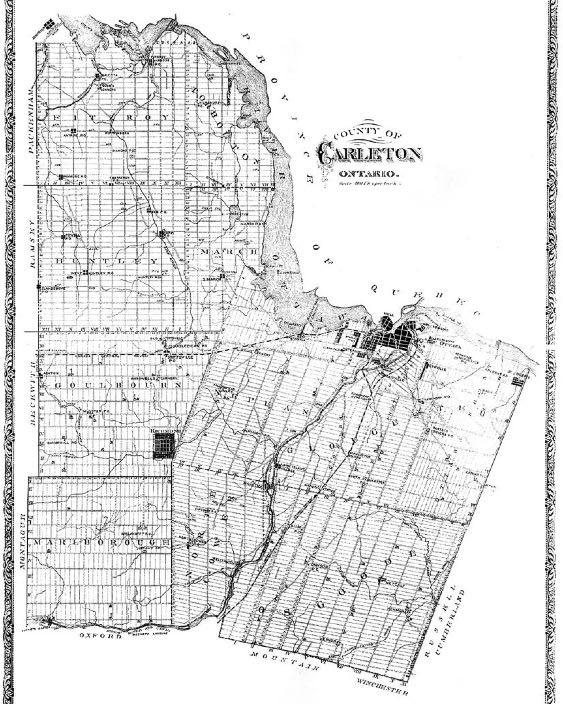
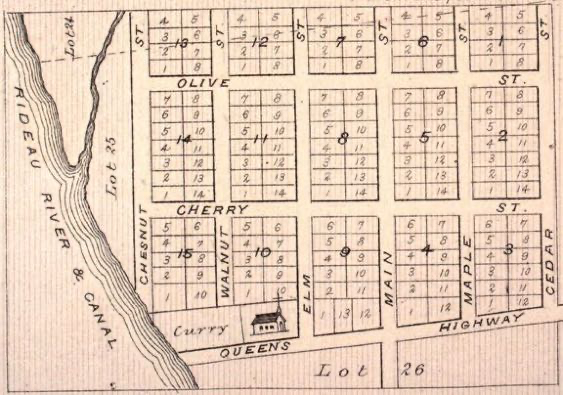
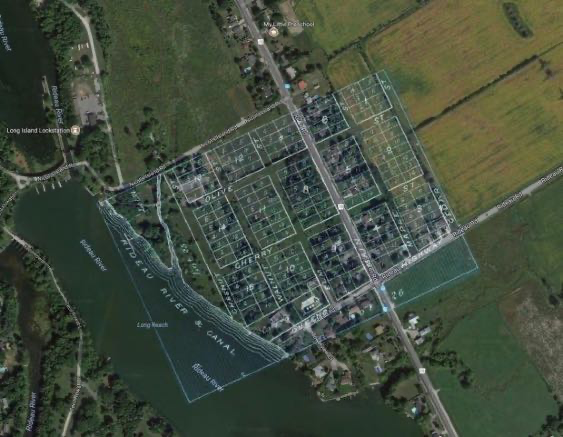
He was then able to overlay Google Earth to get a really good look at where this lost village might have actually been. Most interesting for this writer, was his question about why there was no readily accessible historical plaque or marker denoting the village and sharing a bit about who settled, what happened to it and why. One can speculate! Or one can act! Anybody interested?
In Search of Snake Island
Andrew’s next query was about why Snake Island Road is called Snake Island Road! Well, apparently, there was an island, with several houses on it, and lots and lots of snakes. The story is that someone was bitten by one of those snakes, and according to a contemporary newspaper article, “died from his wounds.”
One of our members pointed out that we have no venomous snakes in this part of the province, and a lively exchange ensued, in which it was pointed out that snakes have disgusting things in their mouths, and an infection would have been likely. Ewwww!
The Atlas shows homesteads and family names which were on Snake Island, and several of those names are still well known in Manotick, but no snakes!
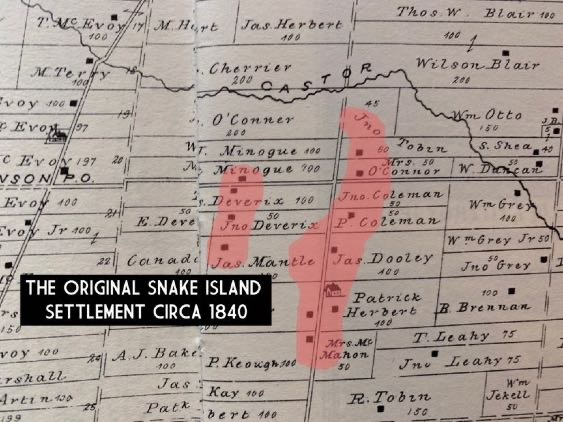
Wide-Ranging Interests
Andrew’s interests range from the large sites discussed above all the way to the most minuscule; what he likes to call “out of place artifacts”. Most interesting to this writer were that both artifacts Andrew shared with us could have ended up in this neck of the woods through extensive indigenous trade routes.
We were lucky to have Dr. Van Loon with us at the meeting in January, and I couldn’t help thinking about his two talks, in which he emphasized that neither Champlain nor Mackenzie would have been successful without the guidance of the indigenous people, and their vast and comprehensive trade routes.
Both of the “out of place artifacts” — a needle holder and some caffeine infused pottery — were evidence of such trade routes. Both artifacts are to be found in the Canadian Museum of History holdings, along with commentary.
Future History
The final section of the formal presentation was really a warning, highlighting the significance of certain architectural styles as “future history”. The case in point was our own Carleton Golf and Yacht Club subdivision which is an early example of a subdivision built around a golf club in North America.
Of as much interest to Andrew as the course itself is the mid-century modern architectural style of many of the homes around the course — a style that, from the outside looking in, may be congruent with the mid 20th century golf course vibe, but certainly not consistent with the requirements of an Ottawa winter! And yet, they prevail, and are a good example of what Andrew likes to call “future history”.
Once Andrew’s presentation was over, there was a lively, far ranging and lengthy discussion, including questions about specific aspects of his talk, but most interesting, questions and discussion about how Andrew reconciled his spare, geometric almost minimalist painting style with the apparent serendipity of his history projects.
This then, came to the heart of the matter: for Andrew, in order to be successful at his chosen vocation (i.e. working artist) he needs the whimsy of our found past. And that is how he seeks his truth and finds his balance.
Thank you, Andrew, for a refreshing look at how one person does history in this day and age.
Links to Andrew’s studio, where you can see more of his artwork, and to his books and blog are posted below.
https://www.andrewkingstudio.com/www.andrewkingstudio.com/Welcome.html
https://www.andrewkingstudio.com/www.andrewkingstudio.com/OTTAWA_REWIND.html
